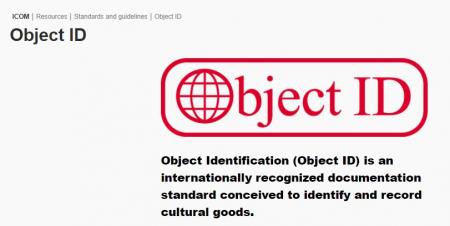Object ID

“Object Identification (Object ID) is an internationally recognized documentation standard conceived to identify and record cultural goods.
It sets a standardised procedure to document and describe collections of archaeological, cultural, and artistic objects. By facilitating the identification of these objects, a standardised description can aid in their recovery in case of loss or theft. Object ID was developed in collaboration with the museum community, police and customs agencies, the art trade, insurance industry, and valuers of art and antiques. It helps to combat the illicit trade of cultural heritage by encouraging the use of the standard and by bringing together organisations around the world that can encourage its implementation.
The illicit trade in cultural objects is now widely recognized as one of the most prevalent categories of international crime. The proceeds of thefts, forgery, ransoms, and smuggling operations involving cultural objects are often used to fund other criminal organisations and terrorist activities, and the objects themselves often serve as both a medium of exchange between criminals and a means of laundering the profits of crime.
Law enforcement agencies have long recognised the importance of good documentation in the fight against art thieves. Documentation is indeed crucial for the protection of cultural objects, for police and customs officers can rarely recover and return objects that have not been photographed and adequately described. Police forces and customs administrations put into the custody of the museums and Ministries of Culture large numbers of objects that have been recovered in the course of operations, but which cannot be returned to their rightful owners because there is no documentation that makes it possible to identify the victims.”
